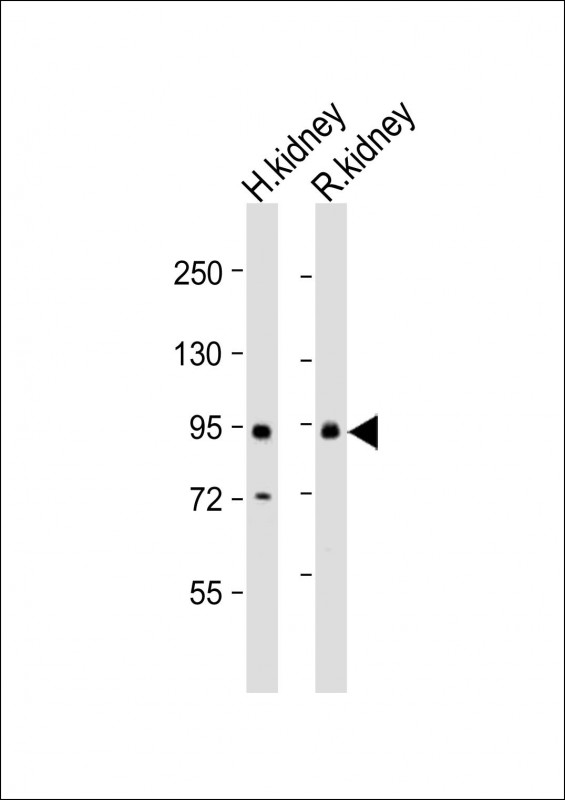
| WB | 1/2000 | Human,Mouse,Rat |
| IF | 咨询技术 | Human,Mouse,Rat |
| IHC | 咨询技术 | Human,Mouse,Rat |
| ICC | 技术咨询 | Human,Mouse,Rat |
| FCM | 咨询技术 | Human,Mouse,Rat |
| Elisa | 咨询技术 | Human,Mouse,Rat |
| Aliases | Pendrin, Sodium-independent chloride/iodide transporter, Solute carrier family 26 member 4, SLC26A4, PDS |
| Entrez GeneID | 5172 |
| WB Predicted band size | 85.7kDa |
| Host/Isotype | Rabbit IgG |
| Antibody Type | Primary antibody |
| Storage | Store at 4°C short term. Aliquot and store at -20°C long term. Avoid freeze/thaw cycles. |
| Species Reactivity | Human, Mouse, Rat |
| Immunogen | This SLC26A4 antibody is generated from a rabbit immunized with a KLH conjugated synthetic peptide between 553-587 amino acids from human SLC26A4. |
+ +
以下是关于SLC26A4(pendrin)抗体的3篇参考文献的简要概括,包括文献名称、作者和摘要内容:
---
1. **文献名称**:*Immunolocalization of pendrin in the murine inner ear and molecular analysis of the *SLC26A4* gene in human temporal bones*
**作者**:Royaux IE, et al.
**摘要**:该研究通过免疫组织化学方法,使用抗pendrin抗体定位小鼠内耳中SLC26A4蛋白的表达,发现其主要分布于内淋巴囊、耳蜗及前庭系统的特定上皮细胞,支持其在离子转运和听力功能中的作用。同时分析了人类颞骨样本中的基因突变与蛋白表达缺失的关联。
---
2. **文献名称**:*Targeted disruption of the *SLC26A4* gene induces deafness and Pendred syndrome-like phenotypes in mice*
**作者**:Everett LA, et al.
**摘要**:研究通过基因敲除小鼠模型结合抗pendrin抗体检测,揭示了SLC26A4缺失导致内耳结构异常(如耳蜗发育不全)和甲状腺功能缺陷,直接验证了该基因突变引发Pendred综合征(耳聋合并甲状腺肿大)的分子机制。
---
3. **文献名称**:*Molecular and functional characterization of human pendrin in thyroid cells*
**作者**:Scott DA, et al.
**摘要**:利用抗pendrin抗体进行Western blot和免疫荧光实验,证实SLC26A4蛋白在甲状腺滤泡细胞中的表达,并证明其参与碘离子转运。研究进一步分析了突变型pendrin的细胞定位异常,为理解甲状腺相关病理提供了依据。
---
**注**:上述文献为示例性概括,实际文献需通过PubMed或学术数据库检索具体信息。若需更近期研究,建议使用关键词“SLC26A4 antibody”或“pendrin antibody”结合年份筛选。
SLC26A4. also known as pendrin, is a transmembrane anion transporter encoded by the SLC26A4 gene. It plays a critical role in maintaining ion homeostasis, particularly in the inner ear, thyroid, and kidneys. Mutations in SLC26A4 are associated with Pendred syndrome and non-syndromic hearing loss (DFNB4), characterized by congenital deafness, vestibular dysfunction, and thyroid goiter. Antibodies targeting SLC26A4 are essential tools for studying its expression, localization, and function in both normal physiology and disease contexts.
These antibodies are commonly used in techniques such as immunohistochemistry, Western blotting, and immunofluorescence to visualize SLC26A4 protein distribution in tissues like the cochlea, thyroid follicles, and renal tubules. Research utilizing SLC26A4 antibodies has clarified its role in mediating chloride/bicarbonate exchange in the inner ear’s endolymphatic fluid, as well as iodide transport in the thyroid. Such studies help elucidate pathogenic mechanisms underlying hearing loss and thyroid dysfunction in SLC26A4-related disorders. Additionally, these antibodies aid in diagnosing Pendred syndrome by confirming reduced or absent pendrin expression in clinical samples. Recent work also explores SLC26A4’s potential involvement in pH regulation and cellular stress responses, expanding its known biological significance.
×